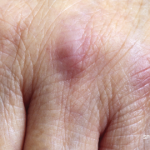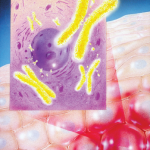Antibodies to TIF1-γ and NXP-2 in dermatomyositis are also associated with increased risk of malignancy. In a study of over 200 patients with dermatomyositis, 83% with cancer-associated dermatomyositis were identified as having antibodies to either TIF1-γ or NXP-2.3 Some literature also suggests that dermatomyositis patients with antibodies to SAE or HMG-CoA may be at an increased risk of cancer as well, but further study is needed.
In contrast, patients with scleroderma and anti-centromere antibodies appear to be at lower risk of cancer than the general population.2
Dr. Shah noted several clinical findings that should increase a clinician’s concern that a patient may have an autoantibody profile associated with an increased risk of malignancy. For example, patients with antibodies to RNA polymerase III tend to have explosive and diffuse onset of cutaneous involvement of their scleroderma; may develop Raynaud’s phenomenon late in the course of disease; and frequently manifest clinical complications, such as scleroderma renal crisis, gastric antral vascular ectasia (GAVE) or inflammatory myopathy. Similarly, the appearance of an ovoid palatal patch in the mouths of patients with dermatomyositis has been associated with the presence of anti-TIF1-γ (p155) antibodies.4
Other Red Flags
Dr. Shah explained that, in addition to autoantibody and clinical findings that raise suspicion for cancer in patients with scleroderma or dermatomyositis, she also screens for red flag findings, such as:
- Older age at disease onset (i.e., >60 years of age);
- Aggressive or atypical disease, or treatment-unresponsive disease;
- Weight loss and constitutional symptoms that appear out of proportion to disease severity; and
- A patient’s personal or family history of cancer.
The basic approach to history taking and examining all patients should include asking about overt cancer risk factors (e.g., smoking, extensive sun exposure); inquiring if patients are up to date with age-appropriate cancer screening, such as colonoscopy and mammography; and performing a breast exam in female patients and a testicular exam in male patients under the age of 40. Dr. Shah also advises a pelvic exam be performed by a gynecologist or other clinician who can evaluate for pelvic masses or other signs of gynecologic malignancies. In female patients with new-onset scleroderma or dermatomyositis, mammography can be offered beginning at age 40 and can be repeated annually. Prostate-specific antigen (PSA) testing should be done for male patients.
Dr. Shah also stated that, in addition to age-appropriate cancer screening with PAP smear and colonoscopy—as guided by such organizations as the U.S. Preventive Services Task Force (USPSTF)—patients with new disease after the age of 65 may reasonably be offered an additional PAP smear, and patients with disease onset after age 75 could be offered an additional colonoscopy. Transvaginal ultrasound may also be considered in cancer screening for female patients.


